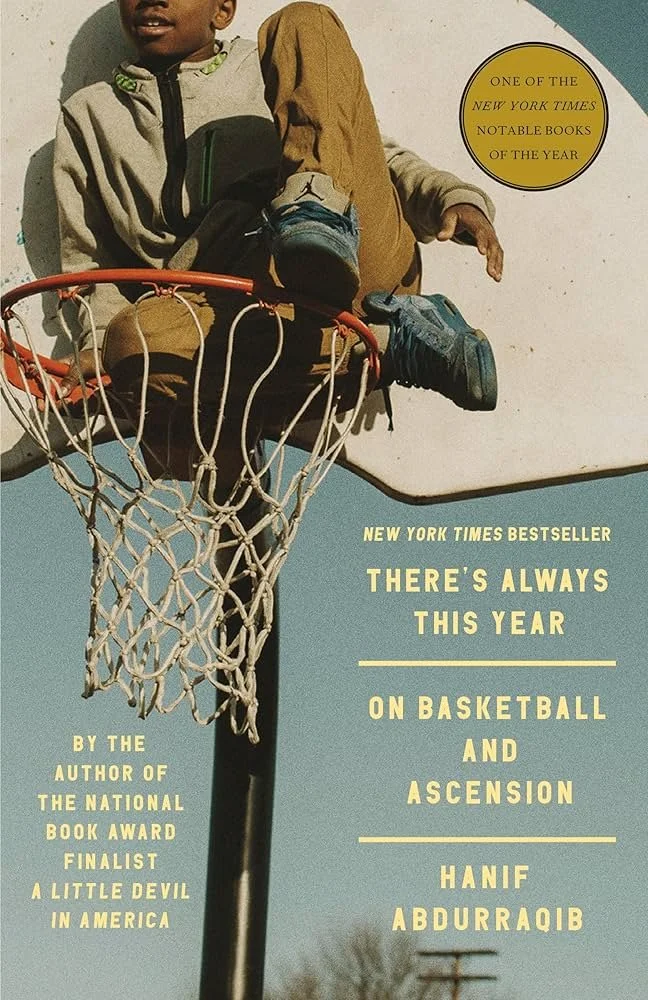Review of Hanif Abdurraqib’s There’s Always This Year
Hanif Abdurraqib is a poet, essayist, and cultural critic from Columbus, Ohio. His poetry has been published in Muzzle, Vinyl, PEN American, and various other journals. His essays and music criticism have been published in The FADER, Pitchfork, The New Yorker, and The New York Times. abdurraqib.com
There’s Always This Year: On Basketball and Ascension (Penguin Randomhouse) is available for purchase here.
Hanif Abdurraqib’s latest book, There’s Always This Year: On Basketball and Ascension, is a staggeringly brilliant work of nonfiction, equal parts memoir, poetry collection, and philosophical treatise. Structured much like an NBA game, with four quarters, timeouts, and a twelve-minute countdown clock that divides each quarter into essayistic vignettes with a heightened sense of urgency, Abdurraqib’s prose carries profound weight, personal insights blossoming into social critique, a harmonious amalgam that juxtaposes the author’s upbringing on the East Side of Columbus and the meteoric rise of Lebron and subsequent coronation as King James of Akron, Ohio. The majority of the book is told in second-person, its main addressee oscillating between the reader, a young Abdurraqib, and occasionally, those he witnessed take flight, a stylistic maneuver that questions the positionality of the audience, who gets to be seen, remembered, and by whom.
In There’s Always This Year—when recounting the stretch of time in which he was unhoused in Columbus—Abdurraqib writes: “Mercy, also, is how the imagination survives.” I can think of no better expression that so succinctly encapsulates the author’s singular voice, which is not to say that Abdurraqib is lenient, but there is a vein of compassion running through his examinations and critiques, a hopeful recognition in the ways a cultural product can make us less estranged, less isolated, critical of the social system while being situated within it. You could say that There’s Always This Year is about basketball, with the crucial understanding that sports are not just temporary, escapist distractions, more of a tool for survival. Any diehard sports fan whose team—the one passed down to them by lineage and geography—is in the midst of a generational, dynastic slump, will likely recognize what the title of the book alludes to: the prayer, the anthem: “there’s always next year.” But in Abdurraqib’s third work of nonfiction, basketball is not necessarily the central thematic concern, but more of a unifying frame.
Basketball is the connective tissue through which the author ruminates on the nature of impermanence, the dimensions of survival, and the biblical and secular conceptions of mercy, salvation, prayer, ascension, and the act of witnessing. Woven together with unflinching autobiographical detail, There’s Always This Year dives, unflinchingly, into racial injustice in the U.S., gentrification, fatherhood, the carceral system, among a myriad of other topics that all coalesce symphonically. Complementing the central narratives are a range of other literary styles that highlight the breadth of Abdurraqib’s talent, including his stunning poetry, frequently employed “in Praise of Legendary Ohio Aviators,” and analytical readings of music and films, such as Spike Lee’s He Got Game (1998), which appear in the “Intermission” between quarters.
Throughout the book, Abdurraqib also ponders with lucid acuity the role of myth, how hometowns find their heroes and speak their legends. The principal narrative is invested in and appreciative of Columbus, Ohio, but muses beyond its boundaries, considering how we imprint on a city even when the landscapes transform beyond our recognition and what it means to have a neighborhood breathe through you, “a place as reprieve, a people as reprieve.” It is an uncontested fact that America is a land soaked in state-induced poverty and police brutality, its art carrying echoes of the nation’s tendency for homeland warfare, sold back to those most directly affected by said violence, an entrenched cycle of destruction that still offers a sense of recognition, a reality Abdurraqib similarly meditates on in his essay collection, They Can’t Kill Us Until They Kill Us (2017).
A hallmark of Abdurraqib’s style is the connections he is able to draw between seemingly disparate concepts; the minute differences in language and culture that we take for granted, but nevertheless have monumental, and in some cases, dire consequences. Take for example the opening section of the book, “Pregame,” where, among other things, Abdurraqib describes baldness with lyric detail, remembering his father’s brow, Michael Jordan’s shaved dome, and his own relationship with his hair, drawing those experiences into a larger conversation on the beauty and baggage of a feature, how baldness becomes coded and read, and the nefarious implications that carries for Black men. Hanif Abdurraqib is unmatched in his ability to construct a vivid system of imagery that traverses the labyrinths of our consciousness with earnest curiosity and unbounded vulnerability.
There’s Always This Year is a rare breed of book, one which demands a second or third or fourth read, each time offering something new to muse. What we can be certain of, though, is that Hanif Abdurraqib has ascended into the exclusive pantheon of literary immortals, and at his most merciful, the work he passes down to us will undeniably continue to broaden the horizon our collective imagining.
Emad Jabini is an Iranian-American writer and educator based in Phoenix, AZ. He earned his MA in Literary and Cultural Studies from the University of Utah and his MFA in Fiction at Arizona State University. His interdisciplinary research and artistic work revolve around themes of liminality, displacement, assimilation, mass media, and pop culture. He has received fellowships and scholarships from the Vermont Studio Center, the Kenyon Review, the Center for Imagination in the Borderlands, and the Virginia G. Piper Center for Creative Writing.
